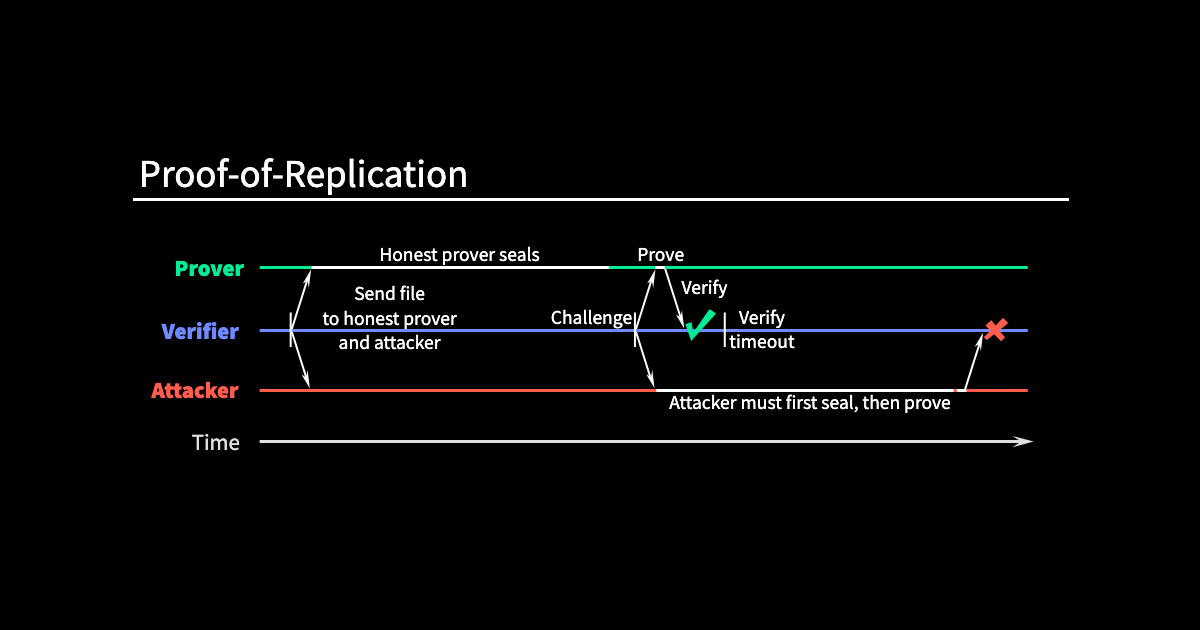Many consensus mechanisms are powered by the blockchain. One such consensus is the Proof of Replication (PoRep).
Proof of Replication is described as a consensus mechanism that proves to blockchain ecosystems that a miner can store and present a replica of data on a dedicated storage space. It integrates two mechanisms, proof-of-space (PoS) and proof-of-reliability (PoR).
Proof-of-reliability (PoR) lets users store data on a server, check whether it is stored, and eventually support data retrieval. On the flip side, proof-of-space (PoS), an example of proof-of-capacity (PoC), allows a user to outsource storage space to a network server.
The blockchain has constantly advanced its banners as a decentralized and trustless financial solution. Multiple upgrades and innovation tools have already been added to the blockchain technology to enable it to keep its promise of being decentralized. Blockchain, being a public network, works based on the interactions among the node operators, developers, investors, and miners.
It is crucial to have implemented agreements that maintain mutual trust between the participants. The agreements are mostly known as a consensus mechanism. They enable groups of independent nodes to stay updated and validate changes within a decentralized network.
The agreements give node operators the power to determine and decide on the next changes to get implemented on the network. In general, every participant in the blockchain keeps a record of the network transactions that ensure they remain synchronized and connected.
Many consensus mechanisms are active on the blockchain. Some of them include proof-of-stake (PoS), proof-of-importance (PoI), proof-of-work (PoW), and delegated proof-of-stake (DPoS). Other notable mechanisms include proof-of-space (PoS) and proof-of-capacity (PoC).
Related: Chia Network And The Proof Of Space Movement
In the proof-of-replication system, participants in the network wish to join in as provers and store a lot of data, since they get network rewards in exchange for the storage space.
Some critics of proof or replication (PoRep) systems insist that while the use of proof of replication by storage providers enhances durability (offers assurance that data is available even in cases of node failures), PoRep overlooks the fact that all replicated data has to be transferred each time a new node gets added to the redundancy pool – which might consume lots of bandwidth.
Proof Of Replication Described
By description Proof of Replication (PoRep) is a consensus mechanism that mainly proves to the blockchain networks that a miner can store and present a replica of data on a dedicated storage space. This integrates two other mechanisms, proof-of-space (PoS) and proof-of-reliability (PoR).
Proof-of-reliability (PoR) lets users store data on a server, check whether it is stored, and support seamless data retrieval. On the contrary, proof-of-space (PoS), an example of proof-of-capacity (PoC), lets users outsource storage space to a network server.
Most of the proof-of-space (PoS) mechanisms let users demonstrate the availability of space to store even junk files. Contrary to PoS, Proof of Replication (PoRep) enables users to store a lot of information in such spaces.
Moreover, it ensures that all the stored data can be retrieved efficiently. Practically, Proof of Replication (PoRep) integrates proof of reliability (PoR) with proof of space (PoS). This combined mechanism is highly useful in decentralized storage networks and cloud computing.
Proof Of Replication Explained Technically
Storage of bits of junk information in the proof-of-space (PoS) consensus mechanism uses just half of the available space to store data. Nonetheless, proof of replication (PoRep) utilizes the available space to store useful information.
Normally, the cost of running a proof of replication (PoRep) is more expensive compared to the proof-of-space (PoS). That is the case since PoRep has to keep useful information together with junk information and retrieve the files.
Technically, a user needs up to 2N of space to operate the proof of replication (PoRep) protocol. The user utilizes 50% of 2N to operate a standard PoS protocol that fills the space with random data. The remaining half is then used to store important information of size N and produce PoRs of the files.
Proof of replication (PoRep) needs the user to create k redundant copies of the stored files. Then, the user requires kN space to store k copies of the file together with another kN space to store randomly. To pass the protocol, (k+1)N space is required for efficient storage of random data and just one copy of a file.
PoRep has various components and properties that are the same as other pricing schemes. The PoRep is publicly verifiable, non-outsourceable, transparent, and dynamic. It is time-bounded and supports effective retrievability. Notably, PoRep allows any party to access public data via a validating key. However, there is no access to private and secretly generated data and information.
The mechanism does not need a special process to access data, offering optimal transparency. The dynamic feature of the PoRep lets users extract and update the stored data and information without having to restart the protocol. To avoid incidents of imposters, miners have to show and prove full PoRep within a specified time.
The PoRep was also perfectly designed to prevent miners from outsourcing their functions to other miners. A miner cannot claim any ownership of other miners’ work since the identity of a prover is verified via proof verification.
Notably, the PoRep mechanism has one main function, which operates effectively in cloud storage and decentralized storage networks. Proof of replication (PoRep) guarantees that the stored data files have a replica that is independent of the original file.
PoRep was developed and utilized by Protocol Labs, the team behind the development of Filecoin. Interestingly, the Filecoin PoRep was designed to serve primarily as a proof of resource instead of proof of work (PoW). It is financially advantageous for the miners since they earn rewards for renting out their idle storage space.
Filecoin’s proof of replication functions both as a proof of storage and proof of space, which are subtly different. In Filecoin, units of data are stored in sectors. Users seal particular data in a sector on disk in a gradual encoding process and commit a proof of that to the blockchain.
Related: How Can Developers Enhance Their Web3 Stack Using Filecoin?
Sealing is a highly intensive amount of work that is spent on that specific proof. For anyone to fake a proof like that, they would need to do that specific work using the original data that a client stores on Filecoin, unlike the numeric hashes in Bitcoin’s proof of work.
Proof Of Replication versus Proof Of Work
So far, proof-of-work (PoW) has dominated as the most popular consensus mechanism in the blockchain industry. It was mainly popularized by the debut of the Bitcoin (BTC) network in 2009. In that mechanism, a miner (also called a prover) must prove to the validators that some computational effort and work has been conducted.
In contrast, PoRep lets miners prove that there is space for data to be stored and retrieved on their hardware. A normal example of PoRep is Filecoin (FIL). Filecoin enables users to rent out additional storage space in reward for FIL tokens.
Both of these consensus mechanisms do not support any impersonators and exploiters. The PoW is focused on financial decentralization, while PoRep focuses on cloud storage computing. Nobody can tamper with stored data and verified transactions on the PoRep and PoW, respectively.
Both mechanisms are immunized against organized data theft, hacks, Sybil attacks, and other cybercrimes. Proof of work prevents doubling spending while proof of replication works against deduplication.
Benefits Of PoRep
Several benefits come with proof of replication (PoRep). Here are some of them.
First, proof of replication develops a channel for a user to hire a server to keep duplicate copies of data. Secondly, PoRep concurrently prevents the users from storing the same kind of file on several servers.
It lets users and servers form a unified Decentralized Storage Network where all the files are stored. Unlike most of the other centralized cloud storage, proof of replication prevents the users from suffering outsourcing attacks, Sybil attacks, and generation attacks.
Related: The Unconventional Guide to Distributed Cloud Technology?
The Takeaway
It is interesting to examine another development of blockchain technology. The exploration, adoption, and use of blockchain are widening each day. This interaction of blockchain and cloud computing will assist in limiting and eventually eliminating the hacks executed against centralized data storage banks. Thus, it is expected to increase the rate of adoption of the decentralized space among traditional tech companies and enthusiasts.
Filecoin is a popular use case of PoRep. It serves as a decentralized earning opportunity for participants. The mechanism joins the league of several other blockchain-earning methods like P2E and decentralized finance (DeFi).
Most notably, regulatory measures need to be implemented to control the storage tariffs of the miners, thereby increasing its advantages over the centralized cloud storage companies.











